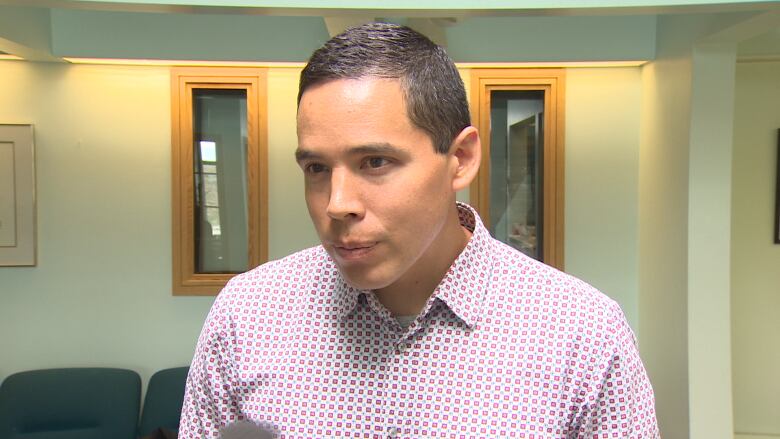Nunavut suicide inquest: Jack Hicks gives expert testimony
'Nunavummiut are soaked in unresolved grief,' testifies expert in suicide statistics
Two people who helped craft the Nunavut Suicide Prevention Strategy testified Tuesday at an inquest into the high rate of suicides and both argued that there has been too little progress to implement the strategy.
From 1999 to 2014, suicide researcher Jack Hicks says the rate of suicide inNunavutwas 9.8 times the national average.

"These are extremely high rates," he testified. "They're tragically high."
Hicks was called as an expert witness, to testify about suicide statistics and research in Nunavut.
Apart from other Inuit regions, Hicks says there are very few populations in the world who have experienced anything like the dramatic increase in the rate of suicide among Nunavut Inuit over the past several decades.
"In some jurisdictions, effective action has been taken [to lower high rates of suicide]and inNunavutbasically nothing had been done."
Nunavut 'soaked in unresolved grief'
Hickspresenteda series of graphs depicting how the rate of suicide in Nunavuthas changed over time, pointing out a peak in the rate of suicide in the early 2000s for youth from 15 to 24 and another increase in the last five to six years for Nunavummiut between the ages of 25and 34.
Looking at how those numbers break down across the territory, Hickssaidthe highest rates of suicide are almost exclusively in the Baffin region.
The reason why people take their own lives is "always complicated andmulti-causal," testified Hicks.
But the researcher did share a hypothesis as to why the rate of suicide peaked when it did.
The spikes, Hickssuggested, coincide with the first generation of Inuit whosefamilies were moved into settlements.
These young Inuit could be affected by intergenerational trauma experienced by their parents and grandparents, argued Hicks,because of residential schools, the dog slaughter, resettlement and other historic tragedies.
In turn, some of these youth likely grew up inhouseholds with relatives who continue tosuffer through lingeringpain and anger.
"Nunavummiut are soaked in unresolved grief," testified Hicks, suggesting that counselling and support for families after they lose a loved one to suicide should become a key priority.
'Little' progress made
Earlier yesterday, the coroner's office tabled an evaluation of the Nunavut Suicide Prevention Strategy and Action Planas evidence.

The report says Nunavut has made progress on this issue, but far more work needs to be done.
Natan Obed, director of social and cultural development for Nunavut Tunngavik, Inc., said he approvesof the report's 42 recommendations, although he wouldn't necessarily endorse each one.
Despite the best intentions ofthe strategy's four partners, the Government of Nunavut, Nunavut Tunngavik Inc., the RCMP and the Embrace Life Council, the timeline for actions has not been followed.
"It isn't a lack of will per se, but it is a failure to complete."
Obed says that failure comes down to two main issues: a lack of dedicated funding and the high turnover of staff in the territory.
"Some of these challenges will never go away," saidObed.The key will be a "willingness to fight through any obstacles."
The strategy itself was approved in 2010.
A year later, when the action plan was ready, Hicks says it "disappeared within the government bureaucracy."
When it was ultimately tabled in the Nunavut Legislative Assembly, Hicks saysthe'resources required' column, which laid out necessary funding, had been removed by the government without the approval of the strategy's other partners.
"We respect each one of the partners,"Obedtestified. "The concern of the partnership is that [decisions are]made in partnership."
The Government of Nunavutneeds toacknowledge that this is not a government strategy, Obedsaid.
If they can't do that, "I do hope they end the partnership."
Lack of funding slowed progress
"In the beginning I think we were overly ambitious," testified Obed.
Soon,it became clear that an influx in funding that would have allowed the partnership to achieve the goals set out in the action planwas not coming.
"We've had to cobble together funding from various sources."
In a list of recommendations, Hicks testified that the government needs to fund the implementation adequately or submit a proposal to the federal government arguing that there needs to be financial support for this regional crisis.
"The problem is not the strategy," he said. "The problem is the implementation of the strategy.
"I agree that actually very little progress has been made."
If you are feeling suicidal you can call the Kamatsiaqtut Help Line. It is anonymous and confidential: (867) 979-3333 or (800) 265-3333. You can also call the Kids Help Phone to speak to a counsellor: 1-800-668-6868.












_(720p).jpg)


 OFFICIAL HD MUSIC VIDEO.jpg)
.jpg)



























































































